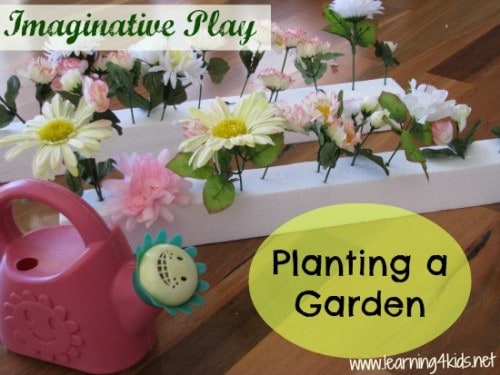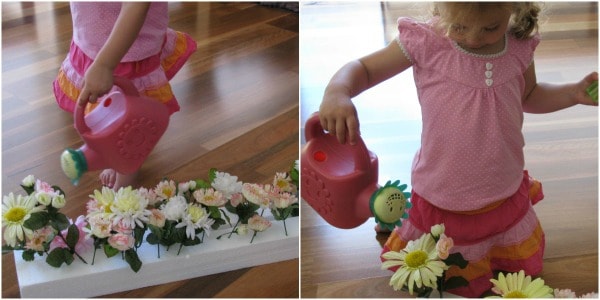
Imaginative play would have to be one of my most favourite kinds of play. I love how children can freely explore an imaginary world and benefit so much from it.
We have been spending a fair bit of time in our garden with the beautiful warm summery weather. As a follow on activity to our Spring Play Dough and to re-enact our time spent in the garden I thought I would set up this invitation to play imaginatively, Planting a Garden.
My girls spent hours planting, re-planting, weeding, sprinkling seeds and watering their imaginative play garden.
You can find out more about what imaginative play is and how to encourage it with kids by following the link: What is Imaginative Play and How to Encourage it?
What You Will Need?

We have re-used our Fake Flowers from our Create a Scented Spring Play Dough Garden Activity and the Styrofoam is recycled from a cardboard box from a parcel we received.
Let’s Play

To create an imaginative play garden, you press the firm wire stems from the fake flowers into the Styrofoam. Miss 2 had no trouble pressing them into the Styrofoam but if this is of a concern, you can always pre-make some holes for your child to place the flower stems into.
This activity is such a wonderful way to also practice those fine motor skills!
For older kids, such as my Miss 5 and 6, they created flower garden patterns, alternating certain flowers to create patterns of colours and flower types.
Let’s Learn

Miss 2 pretending to water her garden that she created with the Styrofoam and fake flowers. She was also making swishing sounds to go with the watering, priceless!

The magic of imaginative play….. Miss 2 sprinkling her garden with flower seeds from a small container and Miss 5 watering them into the ground.
Learning Benefits of Imaginative Play
- It provides opportunities for children to identify with the adult world. Practice and role play their understanding and interpretation.
- Develop social skills: practicing negotiation skills, turn taking and sharing. Provides opportunities for working out problems and experimenting with solutions.
- Emotional development: Understanding and expressing their feelings through the re-enactment of certain experiences. Taking on roles that encourage discipline and empathy.
- Encourages imagination: Children can be anyone and do anything in the pretend world.
- Develop language skills: practicing listening, looking and talking. Being spoken to and talking with other people, also developing an understanding of what is being communicated through body language such as smiles and nodding.
- I also believe that imaginative play is a great way for children to relax and unwind from their busy lives.

This is lovely, we have experimented with styrofoam but I hadn’t though to combine it with fake flowers.
Thank you for explaining that gardening activities are one of the best ways to encourage creativity among our children. It is also interesting to know that in the absence of an actual garden, an imaginative garden play will also have the same benefit of encouraging creativity. These are interesting tips and I will share them with my wife.